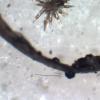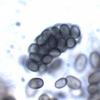
23-11-2025 11:16
Bohan JiaHi, I found small discs growing on dead stem of

21-11-2025 10:56
 Christopher Engelhardt
Christopher Engelhardt
Very small (~0,5 mm) white ascos, found yesterday

21-11-2025 11:52
Jean-Luc RangerBonjour à tous, on voit toujours 2 espèces areni

14-11-2025 16:26
 Marian Jagers
Marian Jagers
Hello everyone, On dead wood of Cytisus scoparius

17-11-2025 21:46
Philippe PELLICIERBonjour,Récolté sur bois pourrissant de feuillu
Dung fungi?
Malcolm Greaves,
08-09-2017 14:06
Can anyone help
Thanks
Mal
Norbert Heine,
08-09-2017 16:07

Re : Dung fungi?
Hallo Mal,
you should compare with Westerdykella nigra (=Preussia nigra).
At first with 8 spores, immediately separating and soon with 32 ascospore segments.
4-5,2 x 2,4-3 µm.
Regards, Norbert
you should compare with Westerdykella nigra (=Preussia nigra).
At first with 8 spores, immediately separating and soon with 32 ascospore segments.
4-5,2 x 2,4-3 µm.
Regards, Norbert
Malcolm Greaves,
08-09-2017 21:08
Re : Dung fungi?
Hello Norbert
I don't have any detailed description of Westerdykella nigra but from what I can gather it is a close relative of Sporormiella. These also split into segments and have a spore septa. Looking more closely at my find the spores do not look to be grouped in the asci and I see no sign of the septa in fact I think I can see droplets at each end of the spores. I don't know if this would rule out the Westerdykella (Preussia) group.
Mal
I don't have any detailed description of Westerdykella nigra but from what I can gather it is a close relative of Sporormiella. These also split into segments and have a spore septa. Looking more closely at my find the spores do not look to be grouped in the asci and I see no sign of the septa in fact I think I can see droplets at each end of the spores. I don't know if this would rule out the Westerdykella (Preussia) group.
Mal
Norbert Heine,
09-09-2017 00:18

Re : Dung fungi?
Hello Mal,
yes, the genus Westerdykella seems to be near to Sporormiella, Preussia.
Another option for the species you found could be W. cylindrica (Asci 17-25 x 9-10).
The asci of W. nigra should be larger (30-40 x 9-11).
We spoke about Westerdykella nigra / cylindrica / multispora in the german Pilzforum.eu some years ago.
At answer #6 you can find two pdf.
In the Doveri article there's a description of W. cylindrica (p. 209-212) and in the article by Ebead et al you can find a key (p. 197-198).
The discussion you will find here (sorry, in german):
https://www.pilzforum.eu/board/thema-westerdykella-cylindrica
Maybe this will help you a little bit more.
Norbert
yes, the genus Westerdykella seems to be near to Sporormiella, Preussia.
Another option for the species you found could be W. cylindrica (Asci 17-25 x 9-10).
The asci of W. nigra should be larger (30-40 x 9-11).
We spoke about Westerdykella nigra / cylindrica / multispora in the german Pilzforum.eu some years ago.
At answer #6 you can find two pdf.
In the Doveri article there's a description of W. cylindrica (p. 209-212) and in the article by Ebead et al you can find a key (p. 197-198).
The discussion you will find here (sorry, in german):
https://www.pilzforum.eu/board/thema-westerdykella-cylindrica
Maybe this will help you a little bit more.
Norbert
Malcolm Greaves,
09-09-2017 01:34
Re : Dung fungi?
Norbert
Reading through those articles W cylindrica looks a perfect match.
Thanks for that.
Mal
Reading through those articles W cylindrica looks a perfect match.
Thanks for that.
Mal






